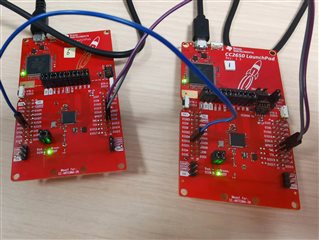Other Parts Discussed in Thread: CC2650, SIMPLELINK-CC13X0-SDK
Dear Engineer,
I am trying to let two CC2650 launchpad communicate with each other using SPI. In "CC2650_LAUNCHXL.h", the PIN defination is
"
/* SPI Board */
#define Board_SPI0_MISO IOID_8 /* RF1.20 */
#define Board_SPI0_MOSI IOID_9 /* RF1.18 */
#define Board_SPI0_CLK IOID_10 /* RF1.16 */
#define Board_SPI0_CSN PIN_UNASSIGNED
#define Board_SPI1_MISO PIN_UNASSIGNED
#define Board_SPI1_MOSI PIN_UNASSIGNED
#define Board_SPI1_CLK PIN_UNASSIGNED
#define Board_SPI1_CSN PIN_UNASSIGNED
"
The CS is PIN_UNASSIGNED, I don't know how to deal with this unsignment, so that the slave can be select. As I learned that only CS=0, the slave is selected.
I used Board_SPI0 and write program as follows.
For master:
"
SPI_Handle spi;
SPI_Params spiParams;
SPI_Transaction spiTransaction;
uint8_t transmitBuffer[MSGSIZE];
uint8_t receiveBuffer[MSGSIZE];
bool transferOK;
SPI_init(); // Initialize the SPI driver
SPI_Params_init(&spiParams); // Initialize SPI parameters
spiParams.dataSize = 8; // 8-bit data size
spi = SPI_open(Board_SPI0, &spiParams);
if (spi == NULL) {
while (1); // SPI_open() failed
}
// Fill in transmitBuffer
spiTransaction.count = MSGSIZE;
spiTransaction.txBuf = transmitBuffer;
spiTransaction.rxBuf = receiveBuffer;
transmitBuffer[2]=2;
transferOK = SPI_transfer(spi, &spiTransaction);
if (transferOK) {
uartTxBufferOffset = System_sprintf(uartTxBuffer,
"\r\n aaa \r\n");
uartTxBuffer[uartTxBufferOffset] = '\n';
UART_write(uart, uartTxBuffer, uartTxBufferOffset + 1);
}else{
uartTxBufferOffset = System_sprintf(uartTxBuffer,
"\r\n bbb \r\n");
uartTxBuffer[uartTxBufferOffset] = '\n';
UART_write(uart, uartTxBuffer, uartTxBufferOffset + 1);
}
"
For slaver,
"
SPI_Handle spi;
SPI_Params spiParams;
SPI_Transaction spiTransaction;
uint8_t transmitBuffer[MSGSIZE];
uint8_t receiveBuffer[MSGSIZE];
bool transferOK;
SPI_init(); // Initialize the SPI driver
SPI_Params_init(&spiParams); // Initialize SPI parameters
spiParams.dataSize = 8; // 8-bit data size
spiParams.mode=SPI_SLAVE;
spi = SPI_open(Board_SPI0, &spiParams);
if (spi == NULL) {
while (1); // SPI_open() failed
}
// Fill in transmitBuffer
spiTransaction.count = MSGSIZE;
spiTransaction.txBuf = transmitBuffer;
spiTransaction.rxBuf = receiveBuffer;
transferOK = SPI_transfer(spi, &spiTransaction);
if (transferOK) {
uartTxBufferOffset = System_sprintf(uartTxBuffer,
"\r\n aaa:%d \r\n",receiveBuffer[2]);
uartTxBuffer[uartTxBufferOffset] = '\n';
UART_write(uart, uartTxBuffer, uartTxBufferOffset + 1);
}else{
uartTxBufferOffset = System_sprintf(uartTxBuffer,
"\r\n bbb \r\n");
uartTxBuffer[uartTxBufferOffset] = '\n';
UART_write(uart, uartTxBuffer, uartTxBufferOffset + 1);
}
"
and the master print aaa, but slave print nothing.
I connect two boards as follows.


